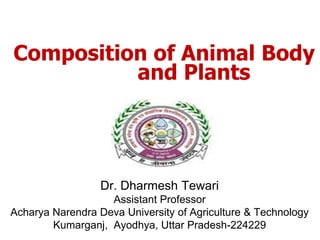
Composition of Animal & Plants Body slide share.pptx
- 1. Composition of Animal Body and Plants Dr. Dharmesh Tewari Assistant Professor Acharya Narendra Deva University of Agriculture & Technology Kumarganj, Ayodhya, Uttar Pradesh-224229
- 2. Composition of Plants • Wide variations in composition Moisture: • principal constituent of living plants is moisture. • moisture content of plants is highly variable. • Young plants have more moisture content. • As the plant mature, the moisture content decreases.
- 4. Carbohydrate: • The dry matter of plant contains mainly carbohydrates. Carbohydrate serves as a structural and reserve material in plants. • In seeds, carbohydrates occur principally as starch while in stems and to a certain extent in leaves a considerable proportion of carbohydrate is present in the form of structural carbohydrates (cellulose, hemicellulose and lignin). • The lignin content of plant tissues increases with maturity of the plant.
- 5. Protein: • Protein is primarily present in active tissue such as the leaf. • As the plant mature there is migration of the protein from the leaves to the seeds to serve as a reserve material for germination. • Young tissues of plant, fruits, and seeds, especially leguminous, are rich in protein.
- 6. Fat: • Fat is present at highest level in the seeds followed by leaves and stem. • Oil-bearing seeds have higher percentage of protein and fat compared to cereals.
- 7. Minerals & Vitamins: • The mineral content of plants is highly variable. • Legumes are rich in Calcium • Seeds are rich in Phosphorus • Cereal grains are low in calcium and sodium • Differs with species and plant parts and is also influenced by soil and other environmental factors. • Vitamins both fat-soluble and water-soluble are also present in plants. • Provitamin A (Beta carotene) • In plants there are various organic acids (citric, malic and fumaric), which are important for metabolism in the cells of plant.
- 8. Factors affecting chemical composition of plants • Soil composition: – Deficiency or excess of minerals is reflected in plant composition. Astragalus -bioindicator plant • Variety and strain of Plant – – Genetic material. eg.Golden rice • Agro-climatic condition – – Atmospheric temperature and humidity • Cultivation practices – – Irrigation, seed rate, time of sowing, fertilizer application, • Stage of growth – The content of crude protein, soluble ash is higher just before flowering and goes down at seed formation stage, – Crude fibre and dry matter content increase as the plant matures. – Fat decreases progressively at maturity of the plant.
- 9. Muscle Approximate Changes in Body Composition as Pigs Grow From Birth to Maturity Skin Bone Newbom Weanling Skin Skin Fat Muscle Bone Muscle Fat Bone Bone Muscle Mid-growth Mature
- 10. Composition of Animals body • J.B. Lawes and J.H. Gilbert analyzed the entire bodies of farm animals and published it in 1859 • Level of water and fat varies inversely • Composition of fat free body: Water: Protein: Ash= 19:5:1(74-76%:20-22%: 3- 5%) Composition of moisture and fat free body: Protein: Ash= 80:20 • Body composition of a moisture free and fat free body is practically constant
- 11. Water • Water content of animal body is variable and decreases as age increases. • For example, –A cattle embryo contains -- 95% water –A new born calf contains -- 75-80% water –5 months old calf contains -- 66-72% water –Mature animal contains -- 50-70% water
- 12. The distribution of water within the body is not uniform. • Blood plasma contains 90-92%, • Heart, kidney and lungs – 80%; • muscles – 75%, • bones – 45% and • tooth enamel only 5% water. Water content of animal body also depends on nutritional status of the animal.
- 13. • Protein along with some inorganic elements is responsible for the structure of the animals. • It is the major constituent of dry matter in muscles, soft tissue, liver, heart, kidney, lungs, intestines, etc. • Muscles contain nearly 75-80% protein. • Protein is also present in hair, nails, feathers, hooves, skin, wool, tendons and bones Protein
- 14. •Fat is the most variable of all components. •Fat content of animal body increases with age. •Usually found in adipose tissues, which is present under the skin, around kidney, around intestine and other internal organs. Fat
- 15. • only around 1% of the total animal body. • being constantly formed and broken down and serves a multitude of functions. • Usually present as glucose or glycogen in liver and muscles. Carbohydrates
- 16. • Animal body contains many minerals. • Amount vary which depend on the function of the particular part of the body. Concentration of some minerals in animal body is as follows: Calcium - 1.3%, Phosphorus - 0.7% Sodium - 0.16%, Potassium - 0.19% Magnesium - 0.04%, Sulphur - 0.15% Inorganic elements
- 17. • Calcium and Phosphorus is the mineral that occurs in largest amount in the body and is almost entirely present in bones and teeth. • Phosphorus is also present in association with proteins, fats and other inorganic salts. • Ca and P are major inorganic component of body and represent 70% of body ash. • Na, K and Cl are present in inorganic form in various fluids. Other minerals form component of tissues, fluids or enzymes. Inorganic elements
- 18. Difference in composition between animal and plants
- 19. Thank You